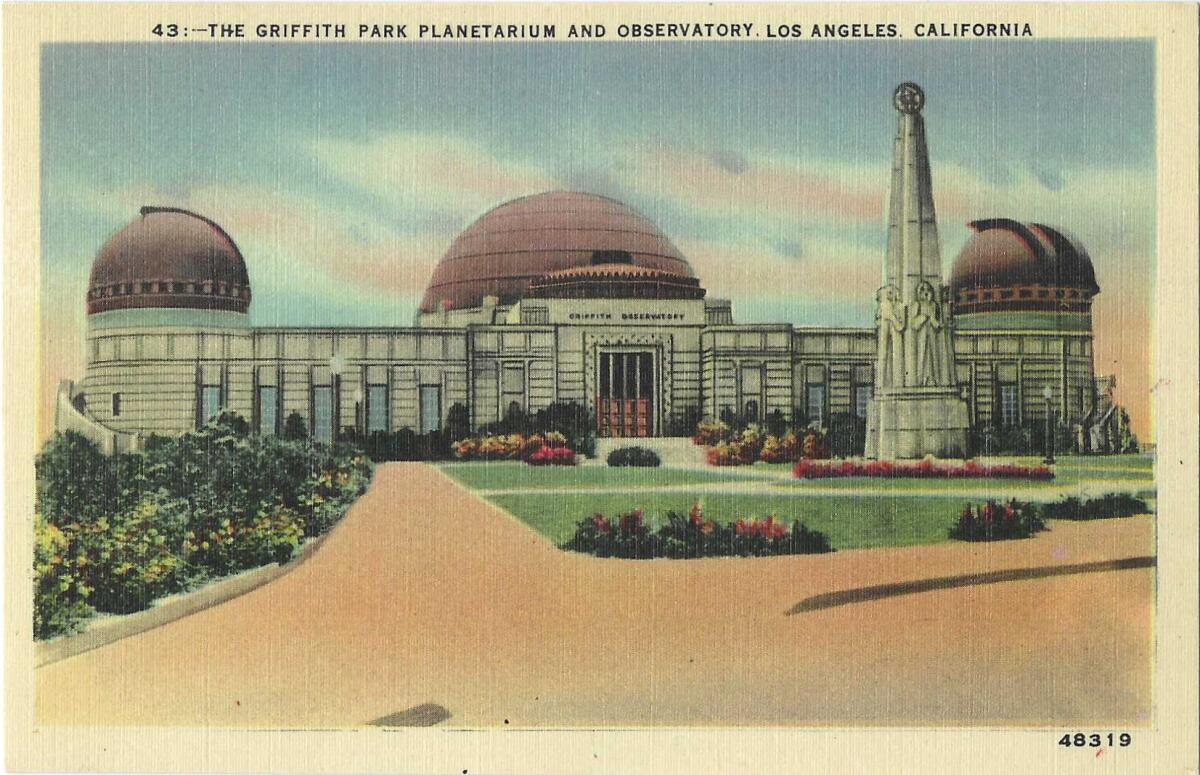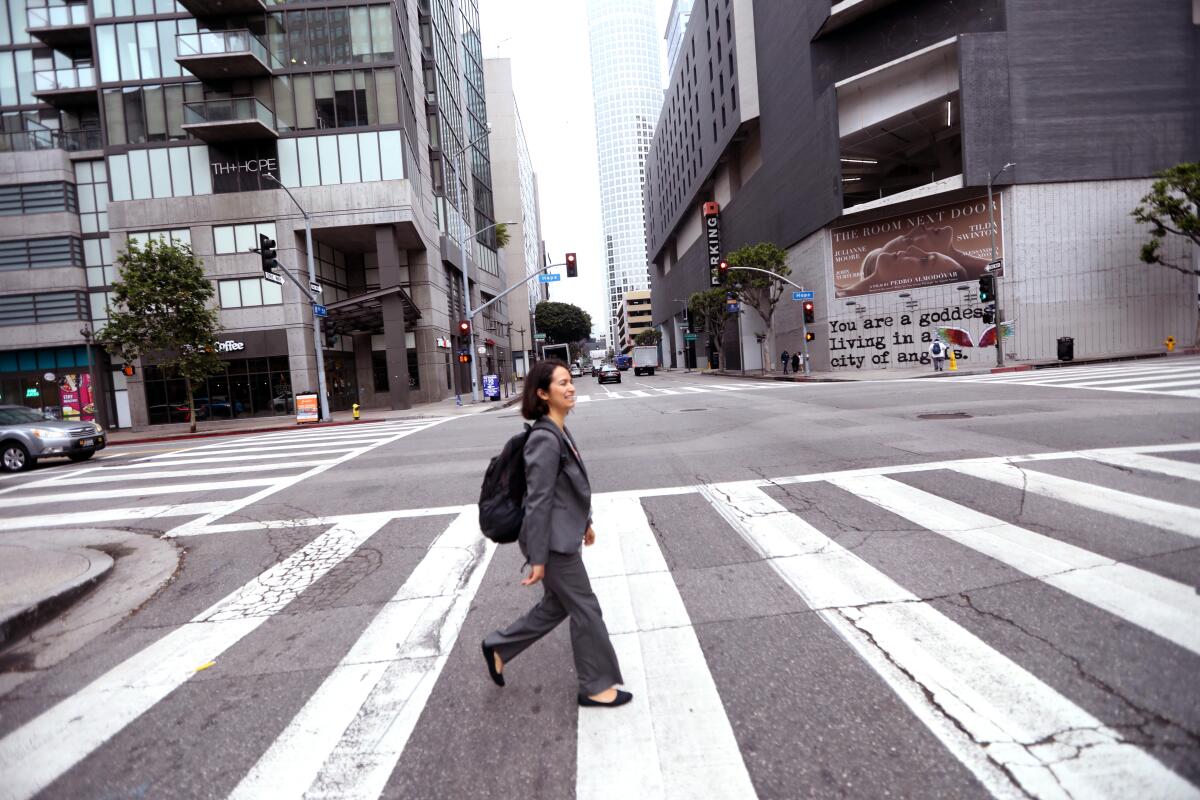He donated the land that became Griffith Park. Then he shot his wife

- Share via
Surely you are familiar with the sprawling, rugged glory of Los Angeles’ Griffith Park. But do you know about the park’s benefactor and namesake, Griffith J. Griffith?
The philanthropist and felon endowed L.A. with what was then the largest urban park in the world and still remains a jewel of the city.
You're reading the Essential California newsletter
The most important California stories and recommendations in your inbox every morning.
You may occasionally receive promotional content from the Los Angeles Times.
He also shot his wife in the face. She survived; he served two years at San Quentin; they divorced. We’ll get to that.
But first, let’s rewind back to December 1896.
Col. Griffith and boomtown L.A.
Los Angeles was a city with great ambitions — a rapidly exploding boomtown that was still in the process of leaving its rancho past behind.
Col. Griffith J. Griffith and his wife, Tina, were the talk of the town, often spotted at theater openings or the opera. She was from a prominent society family. He was a formerly penniless Welsh immigrant who’d made his fortune in mining and other ventures.

Our paper described Griffith as “part visionary and part blowhard.” One acquaintance dubbed him as “midget egomaniac,” another as a “roly-poly pompous little fellow.” He was, by all accounts, bizarre.
His business card just read: “G.J. Griffith, capitalist.” He insisted on being called “Colonel,” though his military title was thought to be entirely phony.
‘A place of rest and relaxation for the masses’
On December 16, 1896, Tina and Griffith donated more than 3,000 acres of hilly splendor to be used as an L.A. public park. The massive, city-altering gift was several times larger than New York’s Central Park.
“It must be made a place of rest and relaxation for the masses, a resort for the rank and file, for the plain people,” Griffith demanded at the time.
Griffith was grandiose and eccentric, but he also believed in shaping the fledgling city, according to Mike Eberts, a historian and author of “Griffith Park: A Centennial History.”
“He was a fellow who wanted to be loved. He wanted to be seen as a great leader. He was also, in his own way, and for his time, something of an idealist,” Eberts said.
Some believed that Griffith’s mighty bequest was also angled, in part, to dodge taxes. But for generations of Angelenos who’ve savored the park, such details are — like Griffith’s military title — mere semantics.
The initial gift brought him great acclaim locally. Here’s how our paper put it in 1898: “No need to ask ‘Who is G.J. Griffith?’ The individuality of the man has impressed itself so deeply and favorably on this community that his name is even as a ‘household word.’”
Seven years later, a dark turn
While thought to be in a delusional — and potentially drunken — stupor in a room at Santa Monica’s Arcadia Hotel, Griffith shot his wife in the face in 1903.
She lost an eye but lived. Our paper breathlessly covered the ensuing trial, which ended with Griffith taking a short trip to San Quentin.
A few years after his release, Griffith (now divorced, according to Eberts) appeared at City Hall once again bearing gifts just before Christmas and hoping to rehabilitate his tarnished image.
“I wish to pay my debt of duty in this way to the community in which I have prospered,” Griffith reportedly told the mayor and City Council as he offered a significant sum of money to build Griffith Observatory.
They accepted, though our paper reported that other citizens and public officials angrily protested the decision.
One prominent community member suggested that the “bribe” would send an egregious message to the city’s youth: “Are you prepared to say to them that if a man is a millionaire he can commit a crime and then with his wealth bribe the community to receive him back into fellowship?”
The city’s parks commission eventually rejected Griffith’s gift, our paper reported, and it wasn’t until after his death in 1919 that it was accepted as a bequest in his will.
The observatory celebrated its 90th birthday this year.
For Eberts, the takeaway is simple: “You don’t have to be a perfect person to do a great thing.”
Today’s top stories

With a surging residency rate, this neighborhood is transforming L.A.
- Despite myriad challenges — including a sprawling homeless population and its reputation as a sometimes dodgy place to live and work — downtown L.A. is staging a comeback by attracting a steady stream of new residents.
- Occupancy in downtown apartments has remained about 90% for more than a year, slightly higher than the level before the pandemic.
ICE raids leave people ‘scared to leave the house’ in a South Bay town
- A sweep near 120th Street and Hawthorne Boulevard this month was one of several that took place in working-class Hawthorne; all part of an immigration enforcement blitz in Southern California that has mostly affected workers living in the country illegally — similar to those that President Trump has employed in the past.
- The incident, which was captured on video and shared on social media along with subsequent raids in the South Bay suburb, has sparked outrage, fear and anxiety in a town where half the population is Latino.
Inside Diddy’s Bad Boy empire of threats, violence and bribes
- Sean “Diddy” Combs’ federal trial in New York City includes an allegation that he was involved in mob family-style racketeering with coercion, kidnapping, threats and beatings done to cover up a pattern of sexual assaults, sex trafficking and prostitution.
- Prosecutors have so far called nearly 30 witnesses to the stand in Manhattan and are expected to finish up with witnesses this week.
- They include three women who described graphic sexual assaults, including key witness and Combs’ onetime lover, Casandra “Cassie” Ventura. It was Ventura’s lawsuit in 2023 that set off the unraveling of the Combs enterprise with its details of sex, violence and “freak-offs.”
What else is going on
- Wildfire threatens structures in eastern San Diego County; evacuations have been ordered.
- As the summer harvest season launches, confusion and uncertainty hang over California fields.
- How Mexican supermarket chains and food merchants are standing up for immigrants.
- Gardeners on ICE raids: ‘People are afraid, but they still have to work.’
- ‘Largest jewelry heist in U.S. history’: 7 indicted in massive Brink’s job.
- Heat advisory is extended. Here’s where Southern California will be sizzling.
- Waymo expands service area in Los Angeles and San Francisco.
- Trump nears historic choice on Iran: Should U.S. join Israel in its attack?
- Anne Burrell, Food Network star and ‘Worst Cooks in America’ host, has died at 55.
Commentary and opinions
- As the Senate loses luster, more members run for governor. Columnist Mark Z. Barabak asks: Is there a takeaway for Kamala Harris?
- Firsthand footage of ICE raids is both witness and resistance, argues guest columnist Allissa Richardson.
This morning’s must-read
Paul Stamets and Jeff Chilton began as friends, their collaboration leading to the rise of medicinal mushroom supplements. Until they disagreed on one important thing: the definition of mushroom.
Other must-reads
- Community garden or ‘rich person’s playground’? Santa Monica gardeners fear 200% price hike.
- This L.A. chef was named the best in California at the James Beard awards.
- In ‘The Waterfront,’ ‘Dawson’s Creek’ creator Kevin Williamson returns to his gritty roots.
- TV milestone: Streaming is now bigger than cable and broadcast combined.
For your downtime

Going out
- Amusement parks: What’s new at SoCal theme parks this summer — from lively night shows to ‘Jaws’ doughnuts.
- National parks: All of Yosemite’s campgrounds will be open this summer for the first time since 2019.
Staying in
- Books: Britney, Taylor and Beyoncé defined the 2000s. In her new book, author Nora Princiotti writes about how they changed pop culture forever.
- Television: 6 TV shows to watch that add a new twist to the spy genre.
- Recipes: Here’s a recipe for summertime pineapple upside-down cake.
- ✏️ Get our free daily crossword puzzle, sudoku, word search and arcade games.
And finally ... your photo of the day

Today’s great photo is from Times photographer Myung J. Chun, outside the Lucas Museum of Narrative Art, which is set to open next year.
Have a great day, from the Essential California team
Kevinisha Walker, multiplatform editor
Andrew Campa, Sunday writer
Karim Doumar, head of newsletters
How can we make this newsletter more useful? Send comments to essentialcalifornia@latimes.com. Check our top stories, topics and the latest articles on latimes.com.
Sign up for Essential California
The most important California stories and recommendations in your inbox every morning.
You may occasionally receive promotional content from the Los Angeles Times.








